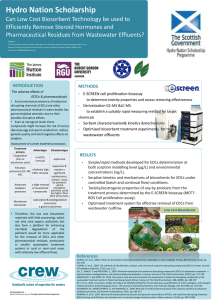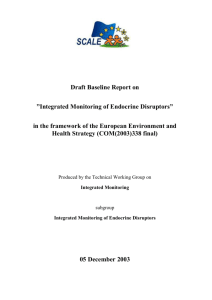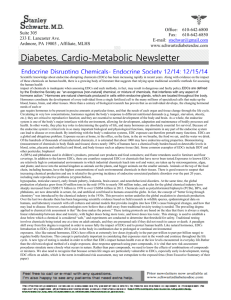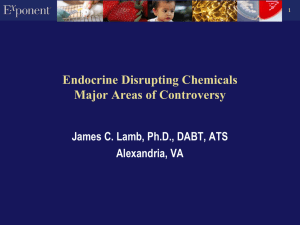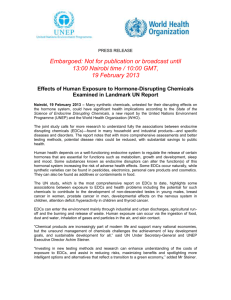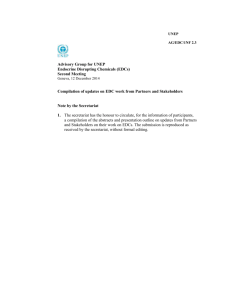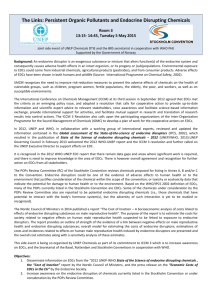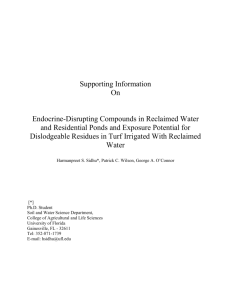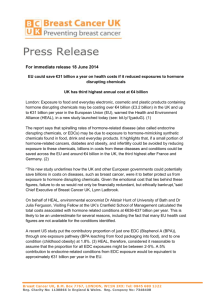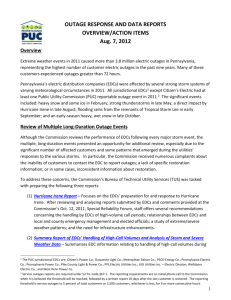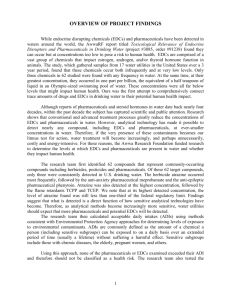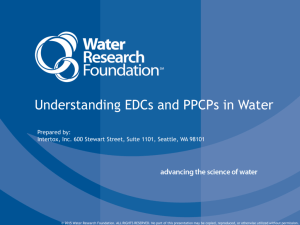2009-DA Morgan-Q1446-endocrine disrupting compounds
advertisement
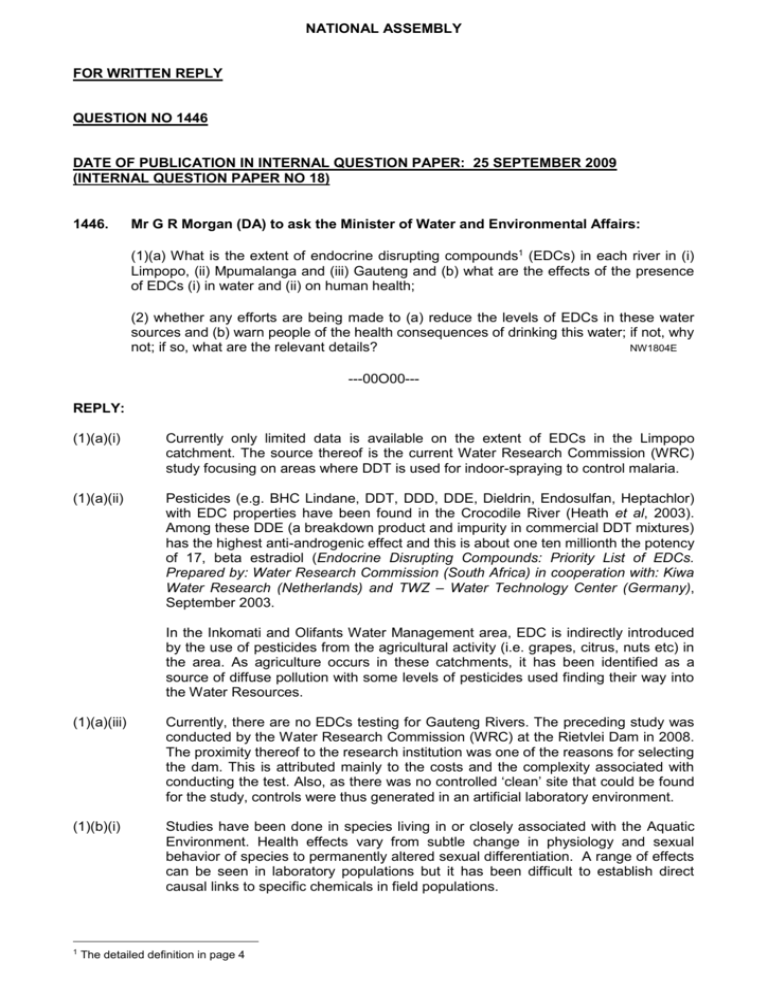
NATIONAL ASSEMBLY FOR WRITTEN REPLY QUESTION NO 1446 DATE OF PUBLICATION IN INTERNAL QUESTION PAPER: 25 SEPTEMBER 2009 (INTERNAL QUESTION PAPER NO 18) 1446. Mr G R Morgan (DA) to ask the Minister of Water and Environmental Affairs: (1)(a) What is the extent of endocrine disrupting compounds1 (EDCs) in each river in (i) Limpopo, (ii) Mpumalanga and (iii) Gauteng and (b) what are the effects of the presence of EDCs (i) in water and (ii) on human health; (2) whether any efforts are being made to (a) reduce the levels of EDCs in these water sources and (b) warn people of the health consequences of drinking this water; if not, why not; if so, what are the relevant details? NW1804E ---00O00--- REPLY: (1)(a)(i) Currently only limited data is available on the extent of EDCs in the Limpopo catchment. The source thereof is the current Water Research Commission (WRC) study focusing on areas where DDT is used for indoor-spraying to control malaria. (1)(a)(ii) Pesticides (e.g. BHC Lindane, DDT, DDD, DDE, Dieldrin, Endosulfan, Heptachlor) with EDC properties have been found in the Crocodile River (Heath et al, 2003). Among these DDE (a breakdown product and impurity in commercial DDT mixtures) has the highest anti-androgenic effect and this is about one ten millionth the potency of 17, beta estradiol (Endocrine Disrupting Compounds: Priority List of EDCs. Prepared by: Water Research Commission (South Africa) in cooperation with: Kiwa Water Research (Netherlands) and TWZ – Water Technology Center (Germany), September 2003. In the Inkomati and Olifants Water Management area, EDC is indirectly introduced by the use of pesticides from the agricultural activity (i.e. grapes, citrus, nuts etc) in the area. As agriculture occurs in these catchments, it has been identified as a source of diffuse pollution with some levels of pesticides used finding their way into the Water Resources. (1)(a)(iii) Currently, there are no EDCs testing for Gauteng Rivers. The preceding study was conducted by the Water Research Commission (WRC) at the Rietvlei Dam in 2008. The proximity thereof to the research institution was one of the reasons for selecting the dam. This is attributed mainly to the costs and the complexity associated with conducting the test. Also, as there was no controlled ‘clean’ site that could be found for the study, controls were thus generated in an artificial laboratory environment. (1)(b)(i) Studies have been done in species living in or closely associated with the Aquatic Environment. Health effects vary from subtle change in physiology and sexual behavior of species to permanently altered sexual differentiation. A range of effects can be seen in laboratory populations but it has been difficult to establish direct causal links to specific chemicals in field populations. 1 The detailed definition in page 4 -2(1)(b)(ii) There is still a scientific debate on potential impact to humans as the argument that if the EDCs affect aquatic species then they might also be affecting humans. Some EDCs may possibly have trans-generational capabilities and thus can affect up to 3 generations under highly conservative scenarios. This makes it difficult to undertake control experiments on humans. The other complicating fact is that humans are generally exposed to EDCs in the form of pharmaceuticals (e.g. birth control pills), personal care products and industrial substances (e.g. fabric softeners and plasticisers) at some point in their life. It becomes difficult to specifically link the exposure route to particular dosages that may pose major health effects. There are significant issues related to effects of mixtures of chemicals and their effects on populations. As a result risk analyses in environmentally typical exposure situations have often been equivocal. (2)(a) My Department has an established monitoring programme for Toxicity. The WRC is funding research through universities and the Council for Scientific Industrial Research (CSIR) to quantify the impact on specific rivers. The pilot phase of the national Toxicity Monitoring programme focused on the detection of persistent organic pollutants (POPs) in order to contribute to the South African report in terms of the Stockhölm Convention. In terms of the study the proposed hot-spot areas selected around Guateng, Mpumalanga and North-West showed the streams were typically in a good state. As the worst case one site could be described as “fair” another as “poor” while the other four sites were still in a good state. The details can be found in: Jooste S, Bollmohr, S and Thwala M (2008) National Toxicity Monitoring Program: Report on Phase 3: Pilot Implementation and Testing of the Design. Report No. N/0000/REQ1008. Resource Quality Services, Department of Water Affairs and Forestry, Pretoria, South Africa. In addition, the Department does routine monthly water analysis for chemical and microbiological testing. Where there are high levels of these compounds, a possible source is investigated and appropriate actions taken to ensure that the level of these compounds is reduced. Conventional treatment (treatment of Waste Water) reduces some level of the EDCs thus reducing the levels that are discharged into water resources. Some EDCs may have an impact on at extremely low levels, often in the pg/kg dose range (a picogram is a millionth of a millionth of a gram). This means that concentrations in water well below chemical detection limits might be beyond the capability of all but the most sophisticated waste treatment facilities to remove some EDCs. In spite of this, one South African study has shown reduced and/or complete removal of estrogenicity by the water treatment process and significant removals were observed after chlorination. Technologically endocrine disruption other than estrogenicity and anti-androgenicity are very difficult to determine and no South African and indeed very few other studies exist. The banning of EDCs (e.g. DDT) use for agricultural purposes also contributes to keeping the levels of EDCs lower that could have found their way into the water resources however DDT is still being used for vector (malaria) control. The few chemical analytical data on surface water suggest that the continued illegal use of banned pesticides may contribute to some the POPs observed in surface waters in South Africa, although DDT (both a POP and an EDC) can be transported over long distances through atmospheric processes. (2)(b) My Department discourages any form of contact sports like swimming in, or drinking water from rivers. This is to prevent/ reduce the chances of being in contact with contaminants which might results in some form of infection as a result of pollutants in the water. -3To deal with pollution related problems and to speed up the response time, My Department also engages with the municipalities and other stakeholders through forums to identify the sources of pollution and integrating monitoring programmes to pick up pollution quickly and respond appropriately. In the Rietvlei Dam where water is used for drinking purposes, water treatment plant uses multiple barriers and the best available technology to ensure that the water purified in the treatment process is of the best quality. The best available technology accessible, as recommended by the United States Environmental Protection Agency (USEPA), for removal of EDCs, as well as a number of other contaminants is used. This technology has been in place at Rietvlei Water Treatment Plant since 1999. The Water Research Commission has conducted research studies into EDCs in South Africa. The research results are available in the public domain and there were media articles (e.g. Rietvlei story half-baked, Mail & Guardian 25 - 31 May 2007) and scientific debates after these reports were released. Media plays a big role in bringing awareness to issues affecting the society at large. The bigger picture on benefits of using EDCs such DDT vs costs of not using DDT (malaria deaths) should be considered especially for this developing country. The World Health Organization is in agreement with the continued responsible use of DDT for this purpose. The WRC, with support from My Department, is currently working on projects that might contribute to a risk-benefit study on particularly the estrogenic DDT and its congeners. In addition, some of these EDCs will be addressed in the proposed review of the South African Water Quality Guidelines. The other forms of public awareness are done through the Departments of Agriculture, Forestry and Fisheries (e.g. the South African Pesticide Initiative Program) and the Department of Health (e.g. malaria control using DDT). ---oOo--- -4Detailed Definition The endocrine system is a highly complex collection of physiological processes in which a variety of natural and synthetic chemicals may play a greater or lesser role. Notably, natural and synthetic hormones are common chemical messengers in the body. The occurrence of endocrine disruption, (i.e.) disturbance of natural chemical messaging in the endocrine system in the body might be the result of a wide range of natural and synthetic chemicals. Any chemical, whether natural or synthetic which can interact with the body’s endocrine receptors could therefore be an endocrine disrupting chemical (EDC). It must be borne in mind that some pharmaceuticals such as the synthetic birth control hormone ethynyl estradiol, which can be detected in many waste water streams and surface waters, are extremely potent estrogenic disrupters. Beta estradiol, a natural female hormone which is also often detected in water, is also an extremely potent EDC. The body has natural mechanisms to regulate against disruptive effects, so that endocrine disruption usually occurs when: (a) hormones or hormone mimics reach hormone receptors in unusual quantities, and/or (b) the chemicals are present at unusual levels during sensitive development stages, and/or (c) regulation mechanisms are disrupted due to disease. There are three ways to measure endocrine disruption: (i) Retrospectively, by direct observation of response in the target population (e.g.) a human population or a test rat population) by an epidemiological study; (ii) Prospectively, by either using a surrogate response in a biotic model such as a modified yeast species or by inference from chemical analysis of the target environment. In order of decreasing cost and rapidly decreasing confidence in establishing adverse effect, the order is (1) target epidemiology, (2) surrogate model response and (3) chemical analysis.
